Administrative divisions of Ukraine
The administrative divisions of Ukraine (Ukrainian: Адміністративний устрій України, romanized: Administratyvnyi ustrii Ukrainy) are under the jurisdiction of the Ukrainian Constitution. Ukraine is a unitary state with three levels of administrative divisions: 27 regions (24 oblasts, 2 cities with special status and 1 autonomous republic), 136 raions and 1469 hromadas.[1][2]
| Part of a series on the |
| Subdivisions of Ukraine |
|---|
 |
| First level |
| Second level |
| Third level |
The latest administrative reform of July 2020 merged most of the 490 raions and 118 cities of regional significance into 136 raions. The overall structure did not change significantly from the middle of the 20th century. The next level below raions are hromadas.[3]
Following the annexations of Crimea and southeastern Ukraine by the Russian Federation, Autonomous Republic of Crimea and Sevastopol as well as portions of Donetsk, Kherson, Luhansk and Zaporizhzhia Oblasts came under the de facto administration of the Russian Federation. Internationally, most states have not recognized the Russian claims.[4]
Overview
According to Article 133 of the Constitution of Ukraine, the system of administrative and territorial organization of Ukraine consists of: AR Crimea, oblasts, raions, cities, urban raions, towns and villages.[5]
In the 2020 administrative reform, all populated places in Ukraine (except for two cities with special status: Kyiv and Sevastopol) were resubordinated to raions.[6] The new figure of 136 raions includes 10 in the AR Crimea (though they are not presently functional) and Sevastopol.
| Level of subdivision | Territory | Total |
|---|---|---|
| First | autonomous republic | 1 |
| cities with special status | 2 | |
| oblasts | 24 | |
| Second | raions | 136 |
| Third | hromadas | 1469 |
First level
There are three types of first-level administrative divisions: 24 oblasts, 1 autonomous republic and 2 cities with special status.
| Colour | Description |
|---|---|
| An oblast in Ukraine, sometimes translated as region or province, is the main type of first-level administrative division of the country. Ukraine is a unitary state, thus the oblasts do not have much legal scope of competence other than that which is established in the Ukrainian Constitution and by law. Articles 140–146 of Chapter XI of the constitution deal directly with local authorities and their competency. | |
| The administrative status of the Autonomous Republic of Crimea is recognized in the Ukrainian Constitution in Chapter X: Autonomous Republic of Crimea and is governed in accordance with laws passed by Ukraine's parliament. Following the 2014 Crimean crisis the Autonomous Republic of Crimea was illegally annexed by Russia as the Republic of Crimea.[7] | |
| There are two cities with special status: Kyiv and Sevastopol (occupied since 2014). Their administrative status is recognized in the Ukrainian Constitution in Chapter IX: Territorial Structure of Ukraine.[8] Unlike the oblasts and the autonomous republic, the cities with special status only have urban raions and are not subdivided into hromadas. |
List
| Flag | Coat of arms | No. | Name | Area (km2) | Population (2021 estimate) | Population density (people/km2, 2021) | Capital | No. of raions | No. of hromadas | Location |
|---|---|---|---|---|---|---|---|---|---|---|
| 1 | Autonomous Republic of Crimea |
26,081 | 1,967,259 | 75,43 | Simferopol | 10 | — |  | ||
 |
2 | Vinnytsia Oblast | 26,513 | 1,529,123 | 57,67 | Vinnytsia | 6 | 63 |  | |
 |
3 | Volyn Oblast | 20,144 | 1,027,397 | 51,00 | Lutsk | 4 | 54 |  | |
| 4 | Dnipropetrovsk Oblast | 31,974 | 3,142,035 | 98,27 | Dnipro | 7 | 86 | 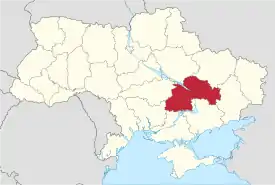 | ||
 |
5 | Donetsk Oblast | 26,517 | 4,100,280 | 154,63 | Donetsk (de jure) Kramatorsk (de facto) |
8 | 66 |  | |
| 6 | Zhytomyr Oblast | 29,832 | 1,195,495 | 40,07 | Zhytomyr | 4 | 65 |  | ||
| 7 | Zakarpattia Oblast | 12,777 | 1,250,129 | 97,84 | Uzhhorod | 6 | 64 |  | ||
| 8 | Zaporizhzhia Oblast | 27,180 | 1,666,515 | 61,31 | Zaporizhzhia | 5 | 67 |  | ||
 |
9 | Ivano-Frankivsk Oblast | 13,928 | 1,361,109 | 97,72 | Ivano-Frankivsk | 6 | 62 |  | |
 |
10 | Kyiv Oblast | 28,131 | 1,788,530 | 63,58 | Kyiv | 7 | 69 | _in_Ukraine.svg.png.webp) | |
| 11 | Kirovohrad Oblast | 24,588 | 920,128 | 37,42 | Kropyvnytskyi | 4 | 49 | 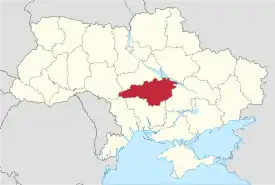 | ||
| 12 | Luhansk Oblast | 26,684 | 2,121,322 | 79,50 | Luhansk (de jure) Bilohorivka (de facto) |
8 | 37 |  | ||
| 13 | Lviv Oblast | 21,833 | 2,497,750 | 114,40 | Lviv | 7 | 73 | 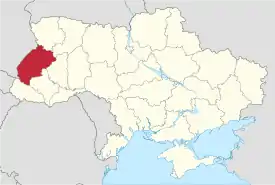 | ||
| 14 | Mykolaiv Oblast | 24,598 | 1,108,394 | 45,06 | Mykolaiv | 4 | 52 |  | ||
| 15 | Odesa Oblast | 33,310 | 2,368,107 | 71,09 | Odesa | 7 | 91 |  | ||
| 16 | Poltava Oblast | 28,748 | 1,371,529 | 47,71 | Poltava | 4 | 60 |  | ||
| 17 | Rivne Oblast | 20,047 | 1,148,456 | 57,29 | Rivne | 4 | 64 |  | ||
| 18 | Sumy Oblast | 23,834 | 1,053,452 | 44,20 | Sumy | 5 | 51 | 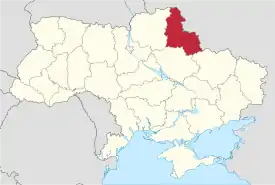 | ||
| 19 | Ternopil Oblast | 13,823 | 1,030,562 | 74,55 | Ternopil | 3 | 55 |  | ||
| 20 | Kharkiv Oblast | 31,415 | 2,633,834 | 83,84 | Kharkiv | 7 | 56 | 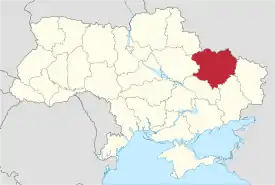 | ||
| 21 | Kherson Oblast | 28,461 | 1,016,707 | 35,72 | Kherson | 5 | 49 |  | ||
| 22 | Khmelnytskyi Oblast | 20,645 | 1,243,787 | 60,25 | Khmelnytskyi | 3 | 60 |  | ||
| 23 | Cherkasy Oblast | 20,900 | 1,178,266 | 56,38 | Cherkasy | 4 | 66 |  | ||
| 24 | Chernivtsi Oblast | 8,097 | 896,566 | 110,73 | Chernivtsi | 3 | 52 | 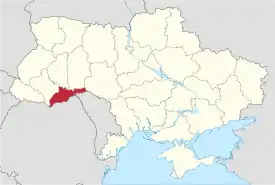 | ||
| 25 | Chernihiv Oblast | 31,865 | 976,701 | 30,65 | Chernihiv | 5 | 57 |  | ||
| 26 | Kyiv | 839 | 2,962,180 | 3530,61 | Kyiv | 10 | — | _in_Ukraine.svg.png.webp) | ||
| 27 | Sevastopol | 864 | 385,870 | 446,61 | Sevastopol | 4 | — |  |
Autonomous republic
The Autonomous Republic of Crimea (Ukrainian: Автоно́мна Респу́бліка Крим) geographically encompasses the major portion of the Crimean peninsula in southern Ukraine. Its capital is Simferopol. The Autonomous Republic of Crimea is the only region within Ukraine that has its own constitution.
On 16 March 2014, after the occupation of Crimea by the Russian military, a referendum on joining the Russian Federation was held. A majority of votes supported the measure. On 21 March 2014, the Russian Duma voted to annex Crimea as a subject into the Russian Federation. The Ukrainian government does not recognize the referendum or annexation of Crimea as legitimate. On 27 March, the UN General Assembly passed Resolution 68/262 by 100 to 11 votes, recognizing the referendum as invalid and denying any legal change in the status of Crimea and Sevastopol.
Oblasts
An oblast (Ukrainian: о́бласть; PL о́бласті) is on the first level of the administrative division of Ukraine.
Most oblasts are named after their administrative center. Volyn and Zakarpattia, whose respective capitals are Lutsk and Uzhhorod, are named after the historic regions Volhynia and Transcarpathia.
Cities with special status
Two cities have special status (Ukrainian: міста́ зі спеціа́льним ста́тусом): Kyiv and Sevastopol. Their special status puts them on the same administrative level as the oblasts, and thus under the direct supervision of the state via their respective local state administrations, which constitute the executive bodies of the cities. Following the annexation of Crimea by the Russian Federation, Sevastopol is controlled by Russia and is incorporated as a federal subject of Russia.[9][10]
Second level
Raions
Raions (Ukrainian: райо́н; PL райо́ни) are smaller territorial units of subdivision in Ukraine. There are 136 raions.[11] Following the December 2019 draft constitutional changes submitted to the Verkhovna Rada by President Volodymyr Zelenskyy, 136 new raions have replaced the former 490 raions of Ukraine.[12]
Urban raions
An urban raion is subordinate to the city administration.[13]
Third level
Hromadas
The territorial hromadas (Ukrainian: територіа́льна грома́да; lit. 'territorial community'), or simlply hromadas (Ukrainian: грома́да) were established by the Government of Ukraine on 12 June 2020 as a part of administrative reform that started in 2015.[14]
There are three types of hromadas: rural (Ukrainian: сільська́ грома́да), settlement (Ukrainian: се́лищна грома́да) and urban (Ukrainian: міська́ грома́да). There are 1469 hromadas in total (as of January 1, 2022).[15]
History
Before the introduction of oblasts in 1932, Soviet Ukraine comprised 40 okruhas, which had replaced the former Russian Imperial governorate subdivisions.[16][17]
In 1932 the territory of the Ukrainian SSR was re-established based on oblasts. At the same time, most of the Western Ukraine at the time formed part of the Second Polish Republic and shared in the Polish form of administrative division based on voivodeships.[18]
- The top level: duchy (land) → palatinate (voivodeship) → regiments (polk) / palanka → governorate → okruha → oblast → TBD
- The intermediate level: apanage duchy → county (povit) / eldership (starostvo) → hundred (sotnia) → raion → county (povit)
- The local level: volost → kurin / community (hromada) → volost → city council (rada) → community (hromada)
References
- Regions of Ukraine and their composition Archived 2011-12-26 at the Wayback Machine. Verkhovna Rada website.
- Paul D'Anieri, Robert Kravchuk, and Taras Kuzio (1999). Politics and society in Ukraine. Westview Press. p. 292. ISBN 0-8133-3538-8
- LiWebRadaAdmin (22 May 2015). "Реформа територіального устрою України". Silrada.org (in Ukrainian). Retrieved 20 October 2022.
- "Putin signs documents to illegally annex four Ukrainian regions, in drastic escalation of Russia's war". The Globe and Mail. 30 September 2022. Retrieved 5 May 2023.
- "Конституція України | від 28.06.1996 № 254к/96-ВР (Сторінка 3 з 4)". 2 April 2019. Archived from the original on 2 April 2019. Retrieved 5 May 2023.
- "Офіційний портал Верховної Ради України". static.rada.gov.ua. Retrieved 12 December 2020.
- "Putin signs Crimea treaty as Ukraine serviceman dies in attack". Reuters. 18 March 2014. Retrieved 18 June 2023.
- "Конституція України". Законодавство України (in Ukrainian). Archived from the original on 29 May 2019. Retrieved 18 June 2023.
{{cite news}}: CS1 maint: bot: original URL status unknown (link) - "About the capital of Ukraine - the hero city of Kyiv (Vidomosti Verkhovnoi Rady Ukrainy (VVR), 1999, № 11, p. 79)". GOV.UA. Verkhovna Rada of Ukraine. Retrieved 4 October 2021.
- "Russia's annexation of Crimea". Kyiv Independent. 14 December 2022. Retrieved 4 May 2023.
- "The council reduced the number of districts in Ukraine: 136 instead of 490". Ukrainska Pravda (in Ukrainian). 17 July 2020.
- "Zelensky's decentralization: without features of Donbas, but with districts and prefects". BBC Ukrainian (in Ukrainian). 16 December 2019.
- "Конституція України". Офіційний вебпортал парламенту України (in Ukrainian). Retrieved 3 May 2023.
- Автор. "Те, чого ніколи не було в Україні: Уряд затвердив адмінтерустрій базового рівня, що забезпечить повсюдність місцевого самоврядування". decentralization.gov.ua. Retrieved 20 October 2022.
- Автор. "Децентралізація в Україні". decentralization.gov.ua. Retrieved 3 May 2023.
- "Адміністративно-територіальний устрій України". ВУЕ (in Ukrainian). Retrieved 7 May 2023.
- "Збірник законів та розпоряджень робітничо-селянського уряду України (1935–1936)". 17 January 2020. Archived from the original on 17 January 2020. Retrieved 7 May 2023.
- "Ustawa Konstytucyjna z dnia 15 lipca 1920 r. zawierająca statut organiczny Województwa Śląskiego". isap.sejm.gov.pl. Retrieved 5 May 2023.
External links
- "Regions of Ukraine and their composition". Verkhovna Rada of Ukraine (in Ukrainian). Archived from the original on 26 December 2011. Retrieved 25 December 2011.
- "Ukraine Raions". Statoids. Retrieved 8 February 2012.
- "Ukrainian cities and regions in alphabetical order". UkraineTrek. Retrieved 10 February 2012.
- "Administrative territorial composition of Ukraine" (PDF). Ministry of Regional Development, Construction, and Communal Living. Archived from the original (PDF) on 24 August 2014. Retrieved 5 April 2015.